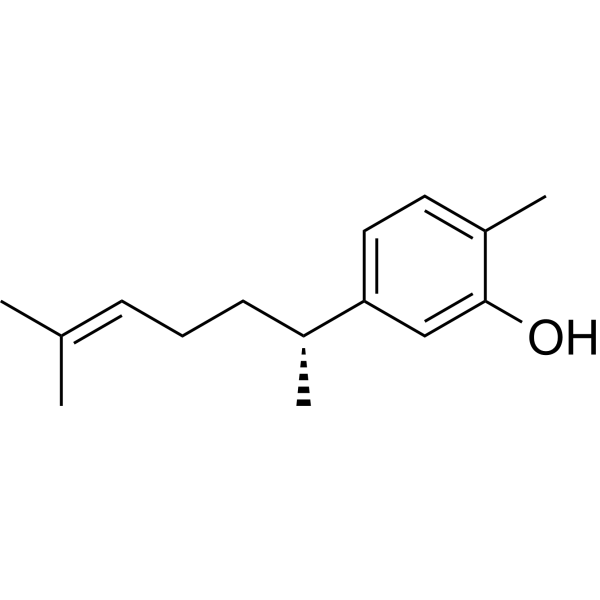
Xanthorrhizol
CAS No. 30199-26-9
Xanthorrhizol( —— )
Catalog No. M26509 CAS No. 30199-26-9
Xanthorrhizol is a natural product isolated from Curcuma xanthorrhiza Roxb. Xanthorrhizol is a potential antibacterial agent.
Purity : >98% (HPLC)
 COA
COA
 Datasheet
Datasheet
 HNMR
HNMR
 HPLC
HPLC
 MSDS
MSDS
 Handing Instructions
Handing Instructions
| Size | Price / USD | Stock | Quantity |
| 5MG | 646 | Get Quote |


|
| 10MG | 897 | Get Quote |


|
| 25MG | 1332 | Get Quote |


|
| 50MG | 1791 | Get Quote |


|
| 100MG | 2421 | Get Quote |


|
| 200MG | Get Quote | Get Quote |


|
| 500MG | Get Quote | Get Quote |


|
| 1G | Get Quote | Get Quote |


|
Biological Information
-
Product NameXanthorrhizol
-
NoteResearch use only, not for human use.
-
Brief DescriptionXanthorrhizol is a natural product isolated from Curcuma xanthorrhiza Roxb. Xanthorrhizol is a potential antibacterial agent.
-
DescriptionXanthorrhizol is a natural product isolated from Curcuma xanthorrhiza Roxb. Xanthorrhizol is a potential antibacterial agent.(In Vivo):Inhibition of ear edema caused by topical use of TPA by pretreatment with xanthine in a dose-related manner (P <0.005).In mice, Topical application of Xanthorrhizol alone does not induce ear edema . All the mice treated with 7.5 nM TPA for 19 weeks after initiation by DMBA developed an average of 15.5±2.3 skin tumors per mouse (tumor multiplicity). Pre-treatment with 2 and 6 μM Xanthorrhizol reduces tumor multiplicity to 6.9±1.1 (P<0.005) and 4.0±1.1 (P<0.005), respectively, at 19 weeks.
-
In VitroXanthorrhizol is a potential antibacterial agent from Curcuma xanthorrhiza against streptocpccus mutants. SEM analysis shows that, treatment of Candida species with MIC of Xanthorrhizol affects the external morphology of these yeasts. Cells incubated in the presence of Xanthorrhizol demonstrate a greater tendency to clump compared with the control cultures. Xanthorrhizol treated C. glabrata cells shows minor abnormalities without a smooth or a slightly awkward surface. Xanthorrhizol-treated Candida cells exhibit deformation and protrusions on the cell surface, which is more clearly demonstrated with C. guilliermondii and C. parapsilosis. In general, Candida exposed to, Xanthorrhizol at concentrations 1 x MICs exhibits substantial ultrastructural abnormalities such as shape deformation, protrusion, rugged cells surface, and clumping.
-
In VivoEar edema induced by the topical application of TPA is suppressed by pre-treatment with Xanthorrhizol in a doserelated manner (P<0.005). Topical application of Xanthorrhizol alone does not induce ear edema in mice. All the mice treated with 7.5 nM TPA for 19 weeks after initiation by DMBA developed an average of 15.5±2.3 skin tumors per mouse (tumor multiplicity). Pre-treatment with 2 and 6 μM Xanthorrhizol reduces tumor multiplicity to 6.9±1.1 (P<0.005) and 4.0±1.1 (P<0.005), respectively, at 19 weeks. In addition, Xanthorrhizol at 2 and 6 μM dose dependently lowers the percentage of tumor-bearing mice (tumor incidence) to 80 and 57%, respectively, at the termination of the experiments. Furthermore, the tumor multiplicity (P<0.05) and incidence are reduced in the DMBA-initiated mice that are topically treated with Xanthorrhizol for 6 weeks after the induction of papillomas with hyperplasia, mild dysplasia and moderate dysplasia by topical TPA application for 6, 18 and 24 weeks, respectively. The increased ODC expression in mouse epidermis with acute inflammation and tumor promotion induced by TPA is inhibited by pre-treatment with Xanthorrhizol in a dose-dependent manner. The topical application of Xanthorrhizol after the induction of papillomas with hyperplasia and dysplasia also potently inhibited ODC expression.
-
Synonyms——
-
PathwayGPCR/G Protein
-
TargetAntibacterial
-
RecptorAndrogen Receptor
-
Research Area——
-
Indication——
Chemical Information
-
CAS Number30199-26-9
-
Formula Weight218.34
-
Molecular FormulaC15H22O
-
Purity>98% (HPLC)
-
Solubility——
-
SMILESC[C@H](CCC=C(C)C)c1ccc(C)c(O)c1
-
Chemical Name——
Shipping & Storage Information
-
Storage(-20℃)
-
ShippingWith Ice Pack
-
Stability≥ 2 years
Reference
1.Dart DA, et al. Novel Trifluoromethylated Enobosarm Analogues with Potent Antiandrogenic Activity?In Vitro?and Tissue Selectivity?In Vivo.Mol Cancer Ther.?2018 Sep;17(9):1846-1858.
molnova catalog



related products
-
6-AZATHYMINE
6-azathymine is a potent inhibitors of D-3-aminoisobutyrate-pyruvate aminotransferase.?6-Azauracil acted as a competitive inhibitor with respect to beta-alanine, and was an uncompetitive inhibitor with respect to pyruvic acid with a Ki of approximately 8.9 mM.
-
ClpB-IN-1
ClpB-IN-1 is a potential antimicrobial agent.ClpB-IN-1 is a potent ClpB inhibitor.
-
Delamanid
A mycolic acid biosynthesis inhibitor found to be free of mutagenicity and to possess highly potent activity against tuberculosis.



 Cart
Cart
 sales@molnova.com
sales@molnova.com


